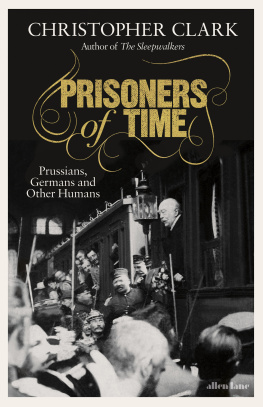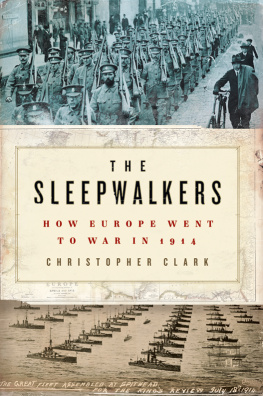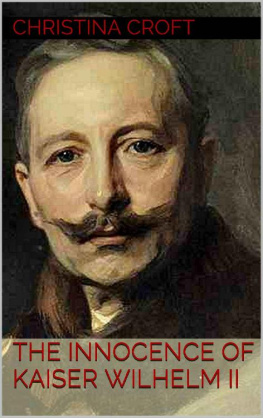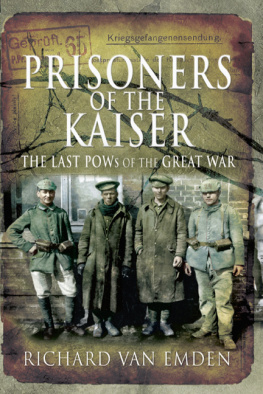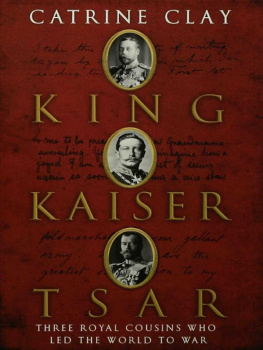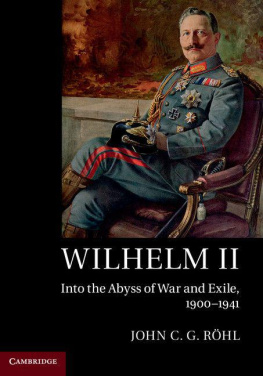Kaiser Wilhelm II
Profiles in Power
General Editor : Keith Robbins
CATHERINE DE MEDICI
R.J. Knecht
ELIZABETH I (2nd Edn)
Christopher Haigh
BURGHLEY
Michael A.R. Graves
JAMES I AND VI
Roger Lockyer
RICHELIEU
R.J. Knecht
GUSTAVUS ADOLPHUS (2nd Edn)
Michael Roberts
OLIVER CROMWELL
Barry Coward
PETER THE GREAT (2nd Edn)
M.S. Anderson
THE ELDER PITT
Marie Peters
THE YOUNGER PITT
Michael Duffy
JOSEPH II
T.C.W. Blanning
ROBESPIERRE
John Hardman
NAPOLEON
Geoffrey Ellis
ALEXANDER I
Janet M. Hartley
DISRAELI
Ian Machin
JUREZ
Brian Hamnett
CAVOUR
Harry Hearder
NAPOLEON III
James McMillan
WILLIAM PENN
Mary K. Geiter
FRANCIS JOSEPH
Steven Beller
ATATRK
A.L. Macfie
LENIN
Beryl Williams
LLOYD GEORGE
Martin Pugh
PTAIN
Nicholas Atkin
HITLER
Ian Kershaw
CHURCHILL
Keith Robbins
NEHRU
Judith M. Brown
ATTLEE
Robert Pearce
NASSER
Peter Woodward
DE GAULLE
Andrew Shennan
FRANCO
Sheelagh Ellwood
MAO
S.G. Breslin
MACMILLAN
John Turner
KENNEDY
Hugh Brogan
CASTRO (2nd Edn)
Sebastian Balfour
GORBACHEV
Martin McCauley
KAISER WILHELM II
Christopher Clark
To my father, Peter Dennis Clark
First published 2000
by Pearson Education Limited
Published 2013
by Routledge 2 Park Square, Milton Park, Abingdon, Oxon OX14 4RN
711 Third Avenue, New York, NY 10017, USA
Routledge is an imprint of the Taylor & Francis Group, an informa business
Copyright 2000, Taylor & Francis.
The right of Christopher M. Clark to be identified as author of this work has been asserted by him in accordance with the Copyright, Designs and Patents Act 1988.
All rights reserved. No part of this book may be reprinted or reproduced or utilised in any form or by any electronic, mechanical, or other means, now known or hereafter invented, including photocopying and recording, or in any information storage or retrieval system, without permission in writing from the publishers.
Notices
Knowledge and best practice in this field are constantly changing. As new research and experience broaden our understanding, changes in research methods, professional practices, or medical treatment may become necessary.
Practitioners and researchers must always rely on their own experience and knowledge in evaluating and using any information, methods, compounds, or experiments described herein. In using such information or methods they should be mindful of their own safety and the safety of others, including parties for whom they have a professional responsibility.
To the fullest extent of the law, neither the Publisher nor the authors, contributors, or editors, assume any liability for any injury and/or damage to persons or property as a matter of products liability, negligence or otherwise, or from any use or operation of any methods, products, instructions, or ideas contained in the material herein.
ISBN 13: 978-0-582-24559-4 (pbk)
British Library Cataloguing-in-Publication Data
A catalogue record for this book can be obtained from the British Library
Library of Congress Cataloging-in-Publication Data
Clark, Christopher M.
William II: the last Kaiser / Christopher M. Clark.
p. cm. --(Profiles in power)
Includes bibliographical references and index.
ISBN 0-582-24559-1 (limp: alk. paper) -- ISBN 0-582-24560-5 (CSD: alk. paper)
1. William II, German Emperor, 1859-1941. 2. Germany--Politics and
government--1888-1918. 3. Germany--Kings and rulers--Biography. I. Title. II. Profiles
in power (London, England)
DD229.C53 2000
943.08'4'092--dc21
[B] 00030939
Typeset by 35 in 10/12 pt Janson Text
Wilhelm II is an ideal subject for Profiles in Power, because the extent of the power wielded by the last German Kaiser has long been the subject of animated historical debate. Was the later Wilhelmine empire governed through a system of personal rule ( persnliches Regiment ); was it a flesh and blood monarchy, in which the character and preferences of the sovereign played a crucial role in shaping political outcomes? Or was power vested in traditional oligarchies and anonymous forces that relegated an inconsequential shadow-Kaiser to the margins of the political process?
Much of the most interesting writing on these issues has focused on the question of whether the term personal rule can rightly be applied to all or part of Wilhelms reign. The debate over personal rule flared up in the early 1950s and has flourished intermittently ever since, fed by analogous disputes over the nature and distribution of power within the National Socialist regime. It has now generated its own sophisticated metaliterature, in which conflicting viewpoints on the power and political impact of Wilhelm II are classified, compared and assessed.
This book does not seek to reopen the debate on personal rule. Useful as the debate has been in connecting the scholarship on the reign with broader questions about the imperial polity, it has been dogged by an underlying uncertainty about definitions. Used as a catchphrase in Wilhelmine political polemic, personal rule meant different things to different people and has never acquired an agreed or stable meaning, a fact that has muddled the scholarly dispute over its applicability to the reign of Wilhelm II. A further problem has been that whereas most historians who use the term agree that the concept fits some parts of Wilhelms reign better than others, no consensus has been reached about when personal rule began and when it came to an end.
This book focuses instead as the guidelines of this series require on the character and extent of the Kaisers power, his political goals and his success in achieving them, and the mechanisms by which he projected authority and exercised influence. It aims to tease out the different kinds of power Wilhelm could exercise in different domains, and the various constraints that he encountered in doing so. It makes no pretence to biography, for which readers are referred to the highly readable studies by Balfour and Cecil, and the definitive multi-volume work now in progress by John Rhl, the worlds foremost expert on this Kaiser and his reign. Although it draws on some unpublished sources, it does not claim to have made crucial new discoveries. It aims at synthesis and interpretation. Above all it asks the question: how much difference did it make that it was Wilhelm II who sat on the German throne during the turbulent years between 1888 and 1918?
Notes and References
J.C.G. Rhl, Germany Without Bismarck. The Crisis of Government in the Second Reich, 18901900 (London, 1967); idem, The kingship mechanism in the Kaiserreich, in Rhl, The Kaiser and His Court. Wilhelm II and the Government of Germany , trans. T.F. Cole (Cambridge, 1994), pp. 10730; H.-U. Wehler, Das deutsche Kaiserreich, 18711918 (Gttingen, 1973), pp. 609.
See e.g. Rhl, The Kaiser and His Court , pp. 18; J.C.G. Rhl, Introduction, in Rhl and N. Sombart (eds), Wilhelm II. New Interpretations (Cambridge, 1982), pp. 122; I.V. Hull, Persnliches Regiment, in J.C.G. Rhl (ed.), Der Ort Kaiser Wilhelms II. in der deutschen Geschichte (Munich, 1991), pp. 223; G. Eley, The View from the Throne: the Personal Rule of Kaiser Wilhelm II, Historical Journal , 28 (1985), pp. 46985; R.J. Evans, William IIs Germany and the Historians, in R.J. Evans, Rethinking German History (London, 1987), pp. 2432; W.J. Mommsen, Kaiser Wilhelm II and German Politics, Journal of Contemporary History , 25 (1990), pp. 289316, esp. pp. 2946; G. Schllgen, Wer machte im Kaiserreich Politik? Zwischen persn-lichem Regiment und polykratischem Chaos, Neue Politische Literatur , 25 (1980), pp. 7997; J. Retallack, Germany in the Age of Kaiser Wilhelm II (Macmillan, Basingstoke, 1996), pp. 39 40, 924.


